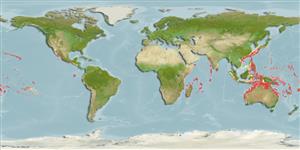Actinopterygii (ray-finned fishes) >
Scorpaeniformes (Scorpionfishes and flatheads) >
Scorpaenidae (Scorpionfishes or rockfishes) > Scorpaeninae
Etymology: Iracundus: Latin, iracundus = choleric (Ref. 45335). More on author: Jordan, Evermann.
Environment / Climate / Range
Ecology
Marine; reef-associated; non-migratory; depth range 20 - 110 m (Ref. 90102). Tropical, preferred ?
Western Indian Ocean: South Africa, Mauritius, Reunion. Pacific Ocean: Ryukyu Islands (Ref. 559), Taiwan, and from the Society, Cook, Marquesan, Tuamoto, Pitcairn and Hawaiian islands.
Size / Weight / Age
Maturity: Lm ? range ? - ? cm
Max length : 13.0 cm TL male/unsexed; (Ref. 3921)
Dorsal
spines
(total): 12;
Dorsal
soft rays
(total): 8-9;
Anal
spines: 3;
Anal
soft rays: 5. Anterior part of dorsal fin resembles a small fish, the fin also has a spot between spines 1-2 or 1-3 (Ref. 4313). Lachrymal bone with 2 spines over maxillary, first points forward, second broad, pointing out and to rear; suborbital ridge without spines except one at rear before opercle; preopercular spines short, usually only 3 developed; no supplemental preopercular spine at base of first spine; a dark spot on the spinous dorsal fin between spines 1 or 2 and 3; and vertical scale rows of about 65-75 (Ref. 10482).
Found on sand and rubble under ledges of seaward reefs (Ref. 9710). Benthic (Ref. 58302). The dorsal fin mimics a tiny fish and is used as a lure (Ref. 9710). Anterolateral glandular groove with venom gland (Ref. 57406).
Life cycle and mating behavior
Maturity | Reproduction | Spawning | Eggs | Fecundity | Larvae
Randall, J.E., 1985. Guide to Hawaiian reef fishes. Harrowood Books, Newtown Square, PA 19073, USA. 74 p. (Ref. 3921)
IUCN Red List Status (Ref. 115185)
CITES (Ref. 94142)
Not Evaluated
Human uses
More information
Common namesSynonymsMetabolismPredatorsEcotoxicologyReproductionMaturitySpawningFecundityEggsEgg development
ReferencesAquacultureAquaculture profileStrainsGeneticsAllele frequenciesHeritabilityDiseasesProcessingMass conversion
Tools
Special reports
Download XML
Internet sources
